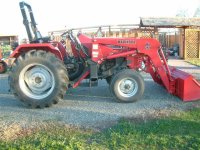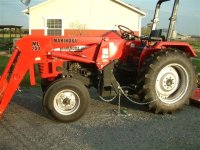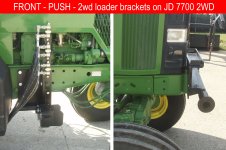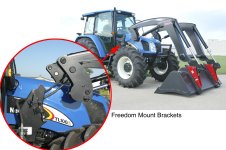Anyone ever put a new loader on an older tractor and come to find that the things is slower than mollasses? How about experience a loader that you can't see over when you drive? The whole purpose of mounting brackets is to merge a loader with a tractor. How well of a job the loader company does, affects how "comfortable" the two units feel when they work together. Positioning too high results in severe tunnel vision, positioning too low requires axle stops or tires to be set out. Positioning to far forward results in a light rear end and low lift capacities. So it is good to see and review how mounts are designed when you are considering a loader.
FRONT-PUSH
The front-push style mounts are typically for 2WD tractors, they attach to your tractor in a way to keep the strain and stress off the smaller front axle. It allows for precision positioning of the loader on the tractor. See 2wd vs. 4WD -
poor fit sits too far forward. Our 2WD loader line is based off the "horsecollar" principle from years ago - which distributes the weight through the entire frame to minimize wear/strain. The design of the mounts allows us to make a faster operating loader with smaller cylinders that is as strong as a 4WD loader. Ideal for older models with slower hydraulic systems.
TWO-POINT MOUNT
All of our loaders utilize a 2 point mounting system on a tractor, except our new freedom mount loader. What we have found is the mid-mount style forces "all" the sideways AND up & down pressures into just one small location on the tractor. The mounts "have" to be heavy and stout and attached with very high grade hardware. They should be checked regularly for proper torque.
The two point mount concept allows us to seure the loader (up & down force) on the tractor in one location (usually midsection) and move forward the attachment point for the side to side force (usually above front axle). This helps minimize the weight of the brackets allowing loader to lift more with less strain and it typically makes the brackets less expensive and more universal to other tractors. This increases the long term value of your loader not just on your tractor but many others in the same HP range. It promotes a "floating" type of connection between the tractor and loader where the are tolerances allow the forces of digging to dissipate through the loader/bracket connection points before being entirely absorbed by the tractor.
The best benefit of the two point mount is that it allows our loaders to automatically guide themselves on or off the tractor without having to mess with lining up pins or using tools. This is user-friendly and allows the loader to lock on automatically after you drive into it.
MID-MOUNT
This style is really tailor made for your tractor - it allows super easy installation - just bolt on two brackets and your done. This could be why you hear them recommended by dealers. The mid-mount or freedom-mount brackets offer more room for tire clearance and fenders and promote a "tight" connection to the tractor. Today's casted framed tractors where the tires oscillate and turn into the body just don't leave room to bolt on brackets. The auto locking features of this style bracket are typically more complex.
I've upload a few different style bracket photos.




